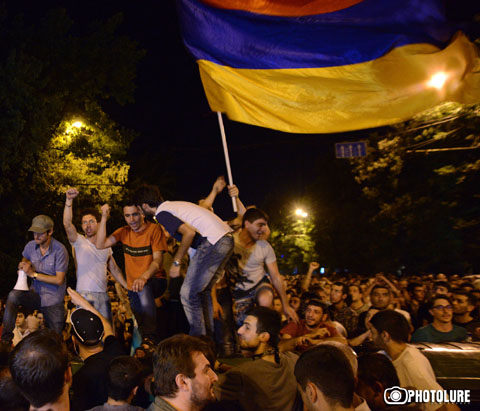Russia, West watching closely Armenia protests
Russia, West watching closely Armenia protests –
By Nayira Hayrumyan
Armenianow – The third day of actions of protest in Yerevan demanding the cancellation of the decision to raise electricity tariffs began with protesters still camped in a central Yerevan street, determined to continue their struggle till a corresponding decision by the authorities.
The events unfolding in Yerevan are being actively covered by the foreign press, and many Russian media call them the Armenian Maidan, drawing parallels with anti-government protests in Kyiv in late 2013, early 2014 that led to the change of government in Ukraine. Like in the case with the Ukrainian protests, they also accuse the West of “inspiring anti-Russian sentiments”.
Lately, the Russian state propaganda commonly uses the word “Maidan” to refer to movements in post-Soviet countries aimed at overthrowing the pro-Russian governments. But during the first two days of protests in Yerevan not a single word about any overthrow of a pro-Russian government was heard and not even demands were made for the nationalization of the infrastructure now being monopolistically owned by Russian state-run or private companies. A purely economic and social demand – to cancel the decision on raising the electricity prices by 7 drams (about 1.5 cents) – has only been raised.
Despite the absence of such appeals and demands, in Russia and elsewhere everyone appears to realize that the economic collapse in Armenia came in the wake of the country’s joining the Russian-led Eurasian Economic Union at the beginning of this year. The unpopular measures being taken by the authorities – such as raising taxes, tariffs, increasing the external debt – only fuel anti-government sentiments.
Commenting on the events in Armenia, Dmitry Pekov, a spokesman for Russian President Vladimir Putin, said that Armenia is a country that is very close to Russia and that in Moscow they are closely watching the developments in Yerevan. The Rosbalt newspaper, reporting on the multi-thousands rallies in Gyumri, reminded that the city in the northwest of Armmenia hosts a Russian military base and mentions that some demonstrators also demand its withdrawal from Armenia.
On Tuesday, diplomatic missions of the United States, the United Kingdom, the European Union, the OSCE Office in Armenia made statements about the use of excessive force by the Armenian police against demonstrators earlier that day. On the morning of June 23, police dispersed a sin-in in Baghramyan Avenue with the use of water cannons and special means. There were also reports about violence used against journalists. And the Western diplomatic missions called for investigations of these cases and for allowing journalists to carry out their professional duties. The Western countries have not made any political statements.
The president of Armenia and the country’s top leaders also refrain from making statements about the protest actions: President Serzh Sargsyan offers to meet with a delegation of demonstrators, but they have rejected the proposal. If the president cancels the decision of the Public Services Regulatory Commission regarding the increase of electricity tariffs, it would mean that the Armenian authorities reject the request of the Russian state company Inter RAO to raise the tariffs. If the president leaves the decision in force, the protests are likely to continue to grow and develop in a yet unknown direction.
The demonstrators are unarmed, they do not allow disrespectful actions towards the police, however, the Vesti news program on a Russian state-run TV channel on June 23 reported that protesters allegedly were armed with iron bars, brass knuckles and truncheons.
Some Armenian analysts say that Moscow, probably, is preparing for the introduction of troops if protests in Yerevan take a clear anti-Russian character.
The countries that are members of the Russian-led Collective Security Treaty Organization (Armenia is a member of this defense pact) have an agreement that in the event of internal disturbances, in case of a given country’s political leadership’s application, the CSTO can introduce troops in this country to stabilize the situation.

